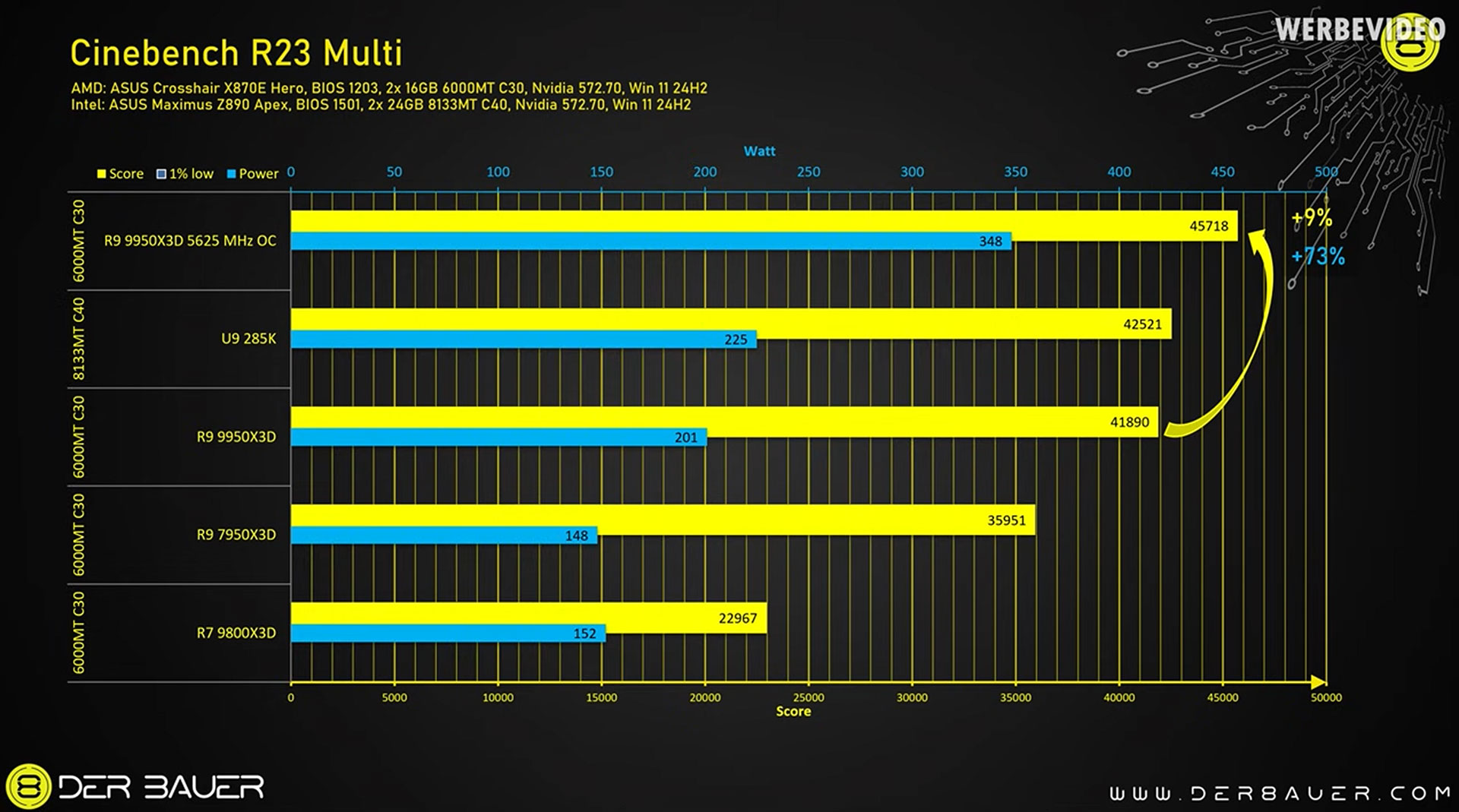Delidded AMD Ryzen 9 9950X3D runs 23 degrees cooler
Alternatively, you can squeeze 9% better performance using 73% more power.

PC overclocking and hardware expert Roman ‘Der8auer’ Hartung has shared his before-and-after AMD Ryzen 9 9950X3D delidding test results. His conclusion: enthusiasts can expect up to 10% higher performance with direct-die cooling, but the cost will be significantly higher power consumption. Alternatively, Der8auer observed that users could run the delidded CPU at stock settings and enjoy far lower temperatures, around 23 degrees Celsius lower in this case, plus improved efficiency. A comfortable compromise might be found between these sampled extremes.
In the above video we see Der8auer introduce the awesome AMD Ryzen 9950X3D, then establish a baseline performance / thermal profile, before the delidding operation. Subsequently, he used the same liquid cooler, settings, and benchmarks to see what benefits the delidding process could deliver.
During the delidding process, Der8auer provided some sage advice. He used the still-compatible Delid-Die-Mate Ryzen 7000 device for the 9950X3D. Please take your time ‘wiggling’ the HIS, perhaps up to 100 times, “until it falls off by itself,” plead the overclocker. An example of a rush job he shared (reproduced below) should be warning enough for would-be delidders to be patient.
The overclocking expert published two charts with the before and after delidding performance and power consumption on show. In the Cinebench R23 multi-thread tests chart, which we embedded below, you can see a key takeaway: the delidded Ryzen X3D chip could deliver up to 9% better performance in this productivity benchmark. However, it is questionable whether the 73% increase in power consumption would be worth it. Der8auer also tested Counter Strike 2 4K during his video, and provided a similar chart.
If you buy the AMD Ryzen 9 9950X3D but don't feel driven to wring every-last-ounce of performance out of it – Der8auer notes that the delidded CPU can run much cooler at stock settings. He seemed impressed that his sample could run at 65 degrees Celsius under load – which is a temperature reduction of 23 degrees Celsius compared to the CPU as shipped from AMD with IHS ‘octopus’ attached. This modded chip also ran at 290W under load, using about 20W less power than the original chip.
If you are interested in more 9950X3D delidding news, we recently retold the hair-raising tale of an ‘amateur’ delidding one of AMD’s best CPUs for gaming using some fishing line and a clothes iron - plus nerves of steel.
Get Tom's Hardware's best news and in-depth reviews, straight to your inbox.

Mark Tyson is a news editor at Tom's Hardware. He enjoys covering the full breadth of PC tech; from business and semiconductor design to products approaching the edge of reason.
-
Dementoss Given that a 9950X3D costs around £700 here in the UK, there's no way I would risk trying delidding.Reply -
JimboCA Imagine if AMD sold delidded CPUs for a small premium. It would take the risk out of it.Reply -
thestryker Reply
TG is selling delidded CPUs with a warranty for a price premium and I think that's likely the best we're going to see even though I agree completely.JimboCA said:Imagine if AMD sold delidded CPUs for a small premium. It would take the risk out of it.
https://www.thermal-grizzly.com/en/blog/new-the-tg-delidded-cpu -
Rpmolloy86 Reply
Honestly, for the price he is charging, it is a an absolute steal of a deal. The labor is practically free when you take in to account the warranty it comes with. The temp drops alone are worth the price. That's a substantial amount of degrees.thestryker said:TG is selling delidded CPUs with a warranty for a price premium and I think that's likely the best we're going to see even though I agree completely.
https://www.thermal-grizzly.com/en/blog/new-the-tg-delidded-cpu -
drivinfast247 Reply
To maintain compatibility with am4 cooling products.jackt said:WOW, why AMD do this to itself ? -
stuff and nonesense Reply
No comment on the temps, the IHS provides mechanical protection to the silicon die. The first socketed Athlons were bare die, people managed to damage them by installing their coolers with uneven pressure. As for the current design.. yes it provides compatibility with AM4 coolers as @drivinfast247 says.jackt said:WOW, why AMD do this to itself ?
It’s a compromise, good enough performance/cost/customer goodwill. -
doomtomb so these companies spend extra money to put these heatspreaders on all their die packages, but it actually decreases thermal performance, even when no one runs this without some sort of fan/heatsink solution. Genius.Reply -
abufrejoval A note of caution: LM is cool, until it isn't.Reply
I got myself one of those "mobile-on-desktop" boards a while back, sporting an Alder Lake i7-12700H soldered to a Mini-ITX board from Erying, one of those small Chinese powerhouses that churn out products when Intel or AMD clear out inventory.
The aim was to use it in a 24x7 µ-server setup where low idle power was more important than peak performance.
As a notebook chip, it comes "naturally delidded" so Erying adds a little shim to make it fit standard desktop coolers, a low-profile Noctua with its own paste between shim and cooler in my case.
That shim had paste on top of the CPU die, which evidently wasn't the best there is, because the chip would throttle so quickly, HWinfo didn't even pick up elevated temperatures, just the throttling cause due to overheat.
And the system really performed more like an ultra-thin notebook, than the "near desktop" peak that I was expecting.
So it took me a while to figure out what was actually going on (how can a CPU heat throttle at 60°C?)
Since the die doesn't have any active components top-side on the die-carrier, and has a bit of a natural basin around it, and was also being mounted horizontally, it felt like the ideal time to test liquid metal cooling, because even replacing the original paste with Noctua's didn't seem to do a lot of good: I guess that paste wasn't even designed to go on a naked die.
The results were fantastic, the chip delivered great "near desktop" performance at 90 Watts while staying below 70°C on a power virus! It would run there four hours, completely stable but still quiet and with relatively low power from the wall plug.
* * *
Actually that system then saw relatively little use for months, as project load changed, but when I did use it again later, I was rather disappointed to see that the throttling had returned.
So I took it apart and noticed that the LM had run away. While on application it seemed as if it was wetting and thus stick to the die, it actually may be non-wetting (like quicksliver) and rather escape natuerally over time, unless it's contained.
In any case it had gathered in a puddle below the die, leaving parts of the chip without contact to the shim and evidently the chip had even started to pit, visibly to the naked eye...
As it turned out there was copper in the shim's alloy, which wasn't obvious from the silvery looks of it. And with copper there seems to be some bad chemistry...
So long story short: do not underestimate the risks of going the LM route. Der Bauer aims for top performance, longevity is hard to test when time compresses (and expands) so badly.
Since paste hadn't been a great experience either, I tried the Kryosheet next... and that might have suffered from me checking perhaps once too often, if it actually sat well on both sides of the shim. In any case it started to develop tears after only one or three re-adjustments.
I had unfortunately listend to Linus on LTT mentioning that these Kryosheets could be reused... today you'll find a disclaimer on Der Bauer's site: only use once...
The system runs with those slightly "raggy" sheets patted down as best as I could, although it's basically limited to 45 Watts TDP--its official limit btw., but without the Turbo oomp that I was really counting on.
In retrospect I'd say that unless you're a die hard modder yourself and don't mind a blown up system in the search for records, for liquid metal you should only buy a fully assembled system with a warranty.
De-lidding the CPU is probably the easier part once you got the tools and the process. Then creating a system that will work with LM for years, is another challenge and currently your personal risk. Both the cooler you put on top of the die and the containment you put around the LM to ensure it doesn't ever go away need to be part of the design to make it work.
When I saw the triple barrier that Nvidia puts around the LM in their Founder's edition RTX 5090, I knew that any lesser design just wouldn't hold ...liquid, long term.
Gaming is so rarely CPU bound these days, that, again, I can only caution going down that rabbit hole. -
ilukey77 Reply
Ive noticed there selling TG de lidded 9800x3d here in AUS $1200aud basically if you add the de lidded TG heat spreader which is recommended ..thestryker said:TG is selling delidded CPUs with a warranty for a price premium and I think that's likely the best we're going to see even though I agree completely.
https://www.thermal-grizzly.com/en/blog/new-the-tg-delidded-cpu
Unless you go the TG direct die water block for custom loops ..
Cool idea for sure but not 100% sure on its over all purpose unless your playing games at 1080p and MAYBE 1440p there may be some gains with a cooler CPU .
To my understanding the 9800x3d is a cooler beast than the 7800x3d and my 7800x3d never gets past 75c under R23 allcore with the 420mm arctic freezer iii ..


